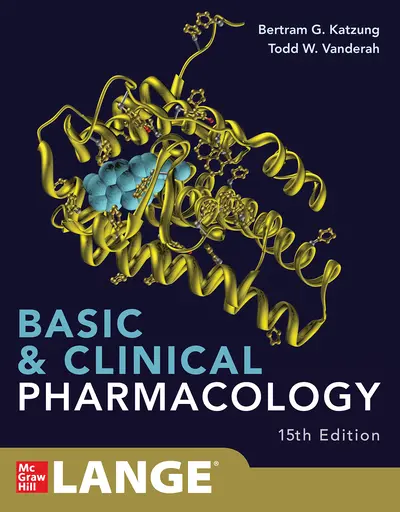My Account Details

ISBN10: 1260452328 | ISBN13: 9781260452327

Step 1 . Download Adobe Digital Editions to your PC or Mac desktop/laptop.
Step 2. Register and authorize your Adobe ID (optional). To access your eBook on multiple devices, first create an Adobe ID at account.adobe.com. Then, open Adobe Digital Editions, go to the Help menu, and select "Authorize Computer" to link your Adobe ID.
Step 3. Open Your eBook. Use Adobe Digital Editions to open the file. If the eBook doesn’t open, contact customer service for assistance.
Master key pharmacological concepts and practices with the most comprehensive, authoritative guide available
Doody's Core Titles for 2023!
Presented in full-color and packed with hundreds of illustrations, Basic and Clinical Pharmacology is the wide-ranging, engaging guide students have counted on for decades.
Organized to reflect the course sequence in many pharmacology courses and in integrated curricula, the guide covers the important concepts students need to know about the science of pharmacology and its application to clinical practice. This edition has been extensively updated to provide expanded coverage of transporters, pharmacogenomics, and new drugs
Delivers the knowledge and insight needed to excel in every facet of pharmacology!.
- Encompasses all aspects of medical pharmacology, including botanicals and over-the-counter drugs
- Major revisions of the chapters on immunopharmacology, antiseizure, antipsychotic, antidepressant, antidiabetic, anti-inflammatory, and antiviral drugs, prostaglandins, and central nervous system neurotransmitters
- New chapter on the increasingly relevant topic of cannabis pharmacology
- Each chapter opens with a case study, covers drug groups and prototypes, and closes with summary tables and diagrams that encapsulate important information
- Revised full-color illustrations provide more information about drug mechanisms and effects and help clarify important concepts
- Trade Name/Generic Name tables are provided at end of each chapter for easy reference when writing a chart order or prescription
- Includes descriptions of important new drugs released through May 2019
- New and updated coverage of general concepts relating to recently discovered receptors, receptor mechanisms, and drug transporters
- Preface
- Preface for Indian Version
- Authors
- Section I Basic Principles
- 1. Introduction: The Nature of Drugs & Drug Development & Regulation
- 2. Drug Receptors & Pharmacodynamics
- 3. Pharmacokinetics & Pharmacodynamics: Rational Dosing & the time Course of Drug Action
- 4. Drug Biotransformation
- 5. Pharmacogenomics
- Section II Autonomic Drugs
- 6. Introduction to Autonomic Pharmacology
- 7. Cholinoceptor-Activating & Cholinesterase-Inhibiting Drugs
- 8. Cholinoceptor-Blocking Drugs
- 9. Adrenoceptor Agonists & Sympathomimetic Drugs
- 10. Adrenoceptor Antagonist Drugs
- Section III Cardiovascular-Renal Drugs
- 11. Antihypertensive Agents
- 12. Vasodilators & the Treatment of Angina Pectoris
- 13. Drugs Used in Heart Failure
- 14. Agents Used in Cardiac Arrhythmias
- 15. Diuretic Agents
- Section IV Drugs with Important Actions on Smooth Muscle
- 16. Histamine, Serotonin, & the Ergot Alkaloids
- 17. Vasoactive Peptides
- 18. The Eicosanoids: Prostaglandins, Thromboxanes, Leukotrienes, & Related Compounds
- 19. Nitric Oxide
- 20. Drugs Used in Asthma & Chronic Obstructive Pulmonary Disease
- Section V Drugs That Act in the Central Nervous System
- 21. Introduction to the Pharmacology of CNS Drugs
- 22. Sedative-Hypnotic Drugs
- 23. The Alcohols
- 24. Antiseizure Drugs
- 25. General Anesthetics
- 26. Local Anesthetics
- 27. Skeletal Muscle Relaxants
- 28. Pharmacologic Management of Parkinsonism & Other Movement Disorders
- 29. Antipsychotic Agents & Lithium
- 30. Antidepressant Agents
- 31. Opioid Agonists & Antagonists
- 32. Drugs of Abuse
- Section VI Drugs Used to Treat Diseases of the Blood, Inflammation, & Gout
- 33. Agents Used in Cytopenias; Hematopoietic Growth Factors
- 34. Drugs Used in Disorders of Coagulation
- 35. Agents Used in Dyslipidemia
- 36. Nonsteroidal Anti-Inflammatory Drugs, Disease-Modifying Antirheumatic Drugs, Nonopioid Analgesics, & Drugs Used in Gout
- Section VII Endocrine Drugs
- 37. Hypothalamic & Pituitary Hormones
- 38. Thyroid & Antithyroid Drugs
- 39. Adrenocorticosteroids & Adrenocortical Antagonists
- 40. The Gonadal Hormones & Inhibitors
- 41. Pancreatic Hormones & Glucose-Lowering Drugs
- 42. Agents That Affect Bone Mineral Homeostasis
- Section VIII Chemotherapeutic Drugs
- 43. Beta-Lactam & Other Cell Wall- & Membrane-Active Antibiotics
- 44. Tetracyclines, Macrolides, Clindamycin, Chloramphenicol, Streptogramins, Oxazolidinones, & Pleuromutilins
- 45. Aminoglycosides & Spectinomycin
- 46. Sulfonamides, Trimethoprim, & Quinolones
- 47. Antimycobacterial Drugs
- 48. Antifungal Agents
- 49. Antiviral Agents
- 50. Miscellaneous Antimicrobial Agents; Disinfectants, Antiseptics, & Sterilants
- 51. Clinical Use of Antimicrobial Agents
- 52. Antiprotozoal Drugs
- 53. Pharmacology of the Antihelminthic Drugs
- 54. Cancer Chemotherapy
- 55. Immunopharmacology
- Section IX Toxicology
- 56. Introduction to Toxicology: Occupational & Environmental
- 57. Heavy Metal Intoxication & Chelators
- 58. Managem
Need support? We're here to help - Get real-world support and resources every step of the way.